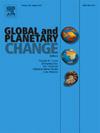Shallow-water redox evolution from the Ediacaran to the early Cambrian: Linkages to the early animal innovations
Abstract
The oceanic oxygenation from the Ediacaran to the early Cambrian (ca. 635–520 Ma) has been commonly linked with the radiation or innovation of early metazoans. However, in this period, the spatio-temporal changes in redox states have not been well constrained for shallow seawater that is proposed to be potential habitats for most metazoans. Here, we report new iodine (I) concentration and Cerium anomaly (Ce/Ce*) data from two Ediacaran–Cambrian carbonate successions in South China. Combined with published data, the new database provides more insights into the evolution of shallow-water redox states on the continental margin. Overall low I/(Ca + Mg) (0.07–1.092 μmol/mol) and high Ce/Ce* (0.64–0.91) indicate frequent presence of low oxygen waters on the Yangtze margin in the early-middle Ediacaran (ca. 635–575 Ma). The initial increases of shallow-water oxygen levels occur from the middle Ediacaran (< ca. 575 Ma), coincident with the rise of the Ediacara biota. However, large variabilities of I/(Ca + Mg) (0.003–4.53) and Ce/Ce* (0.1–0.92) through different sections from the late Ediacaran to the early Cambrian (ca. 575–520 Ma) suggest highly dynamic redox states on both spatial and temporal scales before the Cambrian explosion in a narrow sense. The new I/(Ca + Mg) and Ce/Ce* data bolster the case that the Ediacaran–Cambrian oceans have much lower oxygenation levels than recent fully oxygenated oceans, and frequent redox fluctuations in habitats may have stimulated the early animal innovations.

 求助内容:
求助内容: 应助结果提醒方式:
应助结果提醒方式:


